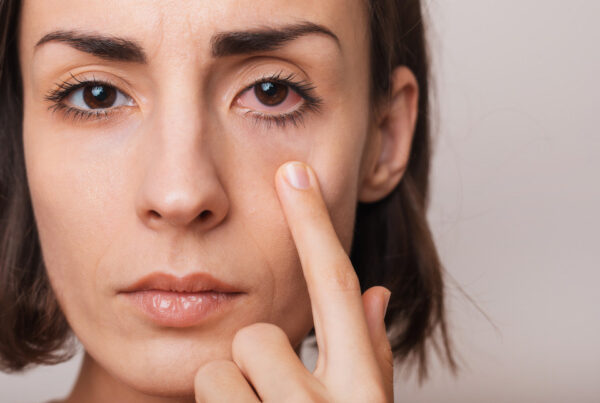

A simulation of an “aura.” It may even grow to cover half of one side of your vision in both eyes
The first time you experienced an “aura,” or the sparkling, colorful, moving zig zags in your vision, I bet you were frightened. Auras are the crazy visuals you notice before the headache part of the migraine sets in. Some people have the auras, and some do not. One third of people get the auras but not the painful headache. The visual commotion typically lasts ~5-30 minutes, but can last up to an hour, and may change or worsen over that time. After the aura subsides, most people will have a very painful headache that is often one-sided and accompanied by light sensitivity, sound sensitivity, and nausea. This headache may last anywhere from 4-72 hours! You may even notice your pupil size changes and tingling/numbness in your limbs. Understandably, some people may mistake these symptoms for a stroke. One way to differentiate is considering the timeline of events. Any vision changes, tingling, numbness, or other neurological symptoms due to a migraine should resolve by 60 minutes. If they do not, it’s important to seek care immediately. Even understanding it isn’t a stroke, it’s a panic-inducing event that you likely want to know why happened.
Migraines can be triggered by various things, or they can be completely random. Common triggers include:
- Changes in temperature and/or barometric pressure
- Stress
- Lack of sleep, irregular sleep
- Caffeine and alcohol intake; Caffeine is interesting- it can be a trigger, but it can also work as a treatment to help stop a migraine
- Dehydration
- Strong smells
- Bright, flashing lights
- Foods/drinks such as chocolate, artificial sweeteners, cheese, cured meats, red wine, and anything containing histamines, MSG, nitrates; you may keep a food diary to try and track possible food triggers
- Hormonal changes, such as being on your menstrual cycle, being on birth control, or going through the phases of menopause. Hormones are a large reason why females are affected 3x more by migraines than males
Everyone’s triggers are different, and if you can pinpoint any of them it’s important to avoid them if possible to prevent a migraine attack.
So why do migraines happen?
Even though we see auras in our vision, the reason we see those auras are due to changes in the brain, not the eye. The eye is generally unharmed by migraines, even though it is seeing the effects of it. The changes are thought to begin a few days before the attack (known as a prodrome phase), and the symptoms you notice may or may not be noticeable. Some people report fatigue, nausea, muscle stiffness, trouble concentrating, irritability, and depression in this period. After the prodrome phase, aura phase, and pain phase, some also experience a “migraine hangover,” or a day of malaise, fatigue, and momentary return of head pain with sudden movements or coughing.
The exact reason why these changes occur isn’t quite understood, but current research points toward abnormal brain activity temporarily affecting chemicals, nerves, and blood vessels in the brain. Basically, signals get sent to cells that excite them which causes a cascade of events that tells the nerves to change the size of the blood vessels in the brain.
One thing researchers know for certain is the hereditary nature of migraines. If you have migraines, there’s a very good chance that your offspring, especially if female, will also get them.
If you experience migraines, it’s important to let your primary doctor know who may just monitor the condition, initiate preventative treatment or treatment to help a migraine stop in its tracks.



